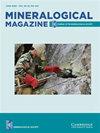银多碱土,Ag16Sb2S11,多碱土族的新成员
IF 1.4
3区 地球科学
Q2 MINERALOGY
引用次数: 2
摘要
摘要:在Kremnica Au–Ag浅成热液矿床中发现了新矿物银硼硅酸盐,理想情况下为Ag16Sb2S11。该矿床位于斯洛伐克BanskáBystrica地区的日亚尔纳德Hronom公司(类型位置)、NováBaõa附近的Šibeničnývrch、斯洛伐克BanskóBystriica地区的日亚诺维卡公司(同类型位置)和Chukotka自治区Anadyr’区的Arykevaam浅成热热液Au–银矿床,俄罗斯联邦(同类型地区)。在Kremnica矿床中,发现了尺寸达4毫米的离散、发育良好的(伪)六方片状晶体,或石英腔中尺寸达5毫米的复杂晶体聚集体和群。它与pyrgyrite、多碱石、stephanite、miargyrite、rozhdestvenskayaite-(Zn)、银四面体-(Zn。银多碱土为深灰色至黑色,具有黑色条纹和金属至不透明光泽。莫氏硬度约为3。它是脆性的,没有明显的解理和贝壳状断裂。计算出的密度为6.403 g·cm–3。在反射光中,银硼硅酸盐为灰色,没有可观察到的双反射性和非常弱的多色性。它在具有弱绿色和绿色-蓝色色调的交叉偏振片中显示出中等的各向异性。IMA矿石矿物学委员会建议的波长反射率值为(Rmin/Rmax,%):30.3/31.0(470 nm)、28.8/29.3(546 nm)、28.1/28.6(589 nm)和27.4/27.8(650 nm)。经验公式(基于29 apfu)为:Kremnica:(Ag15.94Cu0.18)∑16.12(Sb1.40As0.61)∑2.01(S10.60Se0.25Cl0.03)∑10.88,NováBaõa:Ag16.30(Sb1.74As0.22)∑1.96(S10.69Cl0.04)∑10.73和Arykevaam:(Ag15.54Cu0.38)∑15.92(Sb1.56As0.51)∑2.007S11.01。Ag16Sb2S11是银硼硅酸盐的理想端基分子式。Argentopolybasite是三角的,空间群P321,a=15.0646(5)Å,c=12.2552(5。最强的七条粉末X射线衍射线是[dobs inÅ,(I),hkl]:12.169,(40),001;3.162,(100),041;3.045,(54),004;2.881,(45),042;和2.4256,(28),421。Kremnica的银多碱土的晶体结构,在2804次观察到的反射中被细化为Robs=0.0741,证实了该原子排列与多碱土群的其他成员的原子排列是同型的,并且它与银多碱石是同构的。本文章由计算机程序翻译,如有差异,请以英文原文为准。
Argentopolybasite, Ag16Sb2S11, a new member of the polybasite group
Abstract The new mineral argentopolybasite, ideally Ag16Sb2S11, was found at the Kremnica Au–Ag epithermal deposit, Žiar nad Hronom Co., Banská Bystrica Region, Slovakia (type locality), Šibeničný vrch near Nová Baňa, Žarnovica Co., Banská Bystrica Region, Slovakia (cotype locality) and the Arykevaam epithermal Au–Ag deposit, Anadyr’ District, Chukotka Autonomous Okrug, Russian Federation (cotype locality). At the Kremnica deposit argentopolybasite was found as discrete, well-developed (pseudo)hexagonal tabular crystals up to 4 mm in size or as complex crystalline aggregates and groups up to 5 mm in size in cavities of quartz. It is associated with pyrargyrite, polybasite, stephanite, miargyrite, rozhdestvenskayaite-(Zn), argentotetrahedrite-(Zn), naumannite, gold and pyrite. Argentopolybasite is dark grey to black, with a black streak and metallic to opaque lustre. The Mohs hardness is ~3. It is brittle with no observable cleavage and with a conchoidal fracture. The calculated density is 6.403 g⋅cm–3. In reflected light, argentopolybasite is grey, with no observable bireflectance and very weak pleochroism. It shows moderate anisotropy in crossed polarisers with weak greenish and green–blue tints. The reflectance values for wavelengths recommended by the Commission on Ore Mineralogy of the IMA are (Rmin/Rmax, %): 30.3/31.0 (470 nm), 28.8/29.3 (546 nm), 28.1/28.6 (589 nm) and 27.4/27.8 (650 nm). The empirical formulae (based on 29 apfu) are, Kremnica: (Ag15.94Cu0.18)Σ16.12(Sb1.40As0.61)Σ2.01(S10.60Se0.25Cl0.03)Σ10.88, Nová Baňa: Ag16.30(Sb1.74As0.22)Σ1.96(S10.69Cl0.04)Σ10.73 and Arykevaam: (Ag15.54Cu0.38)Σ15.92(Sb1.56As0.51)Σ2.07S11.01. The ideal end-member formula for argentopolybasite is Ag16Sb2S11. Argentopolybasite is trigonal, space group P321, a = 15.0646(5) Å, c = 12.2552(5) Å, V = 2408.61(15) Å3 and Z = 2. The seven strongest powder X-ray diffraction lines are [dobs in Å, (I), hkl]: 12.169, (40), 001; 3.162, (100), 041; 3.045, (54), 004; 2.881, (45), 042; and 2.4256, (28), 421. The crystal structure of argentopolybasite from Kremnica, refined to Robs = 0.0741 for 2804 observed reflections, confirmed that the atomic arrangement is isotypic to that of the other members of the polybasite group and it is isostructural with argentopearceite.
求助全文
通过发布文献求助,成功后即可免费获取论文全文。
去求助
来源期刊

Mineralogical Magazine
地学-矿物学
CiteScore
4.00
自引率
25.90%
发文量
104
审稿时长
6-12 weeks
期刊介绍:
Mineralogical Magazine is an international journal of mineral sciences which covers the fields of mineralogy, crystallography, geochemistry, petrology, environmental geology and economic geology. The journal has been published continuously since the founding of the Mineralogical Society of Great Britain and Ireland in 1876 and is a leading journal in its field.
 求助内容:
求助内容: 应助结果提醒方式:
应助结果提醒方式:


